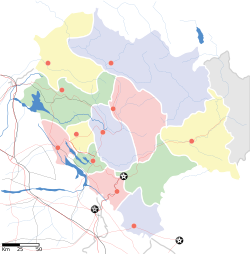Dalhousie, Himachal Pradesh
| Dalhousie | |
|---|---|
| Hill station | |
| Coordinates: 32°32′N 75°59′E / 32.53°N 75.98°ECoordinates: 32°32′N 75°59′E / 32.53°N 75.98°E | |
| Country | India |
| State | Himachal Pradesh |
| District | Chamba |
| Elevation | 2,000 m (7,000 ft) |
| Population (2011) | |
| • Total | 7,051 |
| • Rank | 25 in HP |
| Languages | |
| • Official | Himachali, Punjabi, Pahari |
| Time zone | IST (UTC+5:30) |
| PIN | 176304 |
| Telephone code | +91 1899 |
| Vehicle registration | HP-47 |
Dalhousie is a hill station now in Chamba district, in the northern state of Himachal Pradesh, India perviously it was part of Punjab. It is situated on 5 hills and has an elevation of 1,970 metres above sea level.
Dalhousie Town was named after Lord Dalhousie, who was the British Governor-General in India while establishing this place as a summer retreat.
Religion in Dalhousie(2011)
The Dalhousie is a hill station in Himachal Pradesh, established in 1854 by the British Empire's government in British India as a summer retreat for its troops and officials after annexation of Sikh Empire Punjab.
It is built on and around five hills, Kathalagh, Potreyn, Terah, Bakrota and Bhangora. Located on the western edge of the Dhauladhar mountain range of the Himalayas, it is surrounded by snow-capped peaks. Dalhousie is situated between 6,000 and 9,000 feet (2,700 m) above sea level. It was established on the land of a Sikh Empire Punjab after annexed by British. Dalhousie remains the part of Punjab until 1966. But it was trimmed from Punjab by controversial [[Punjab Reorganisation Act, 1966]. The best time to visit is in the summer, and the peak tourist season is from May to September. Scottish and Victorian architecture are prevalent in the bungalows and churches in the town.
Dalhousie is a gateway to the ancient Chamba Hill State, now Chamba District of the state of Himachal Pradesh of India. This hill region is a repository of ancient Hindu culture, art, temples, and handicrafts preserved under the longest-running single dynasty since the mid-6th century. Chamba is the hub of this culture. Bharmour, the ancient capital of this kingdom, is home to the Gaddi and Gujjar tribes. It has 84 ancient temples dating from the 7th–10th centuries AD.
...
Wikipedia


